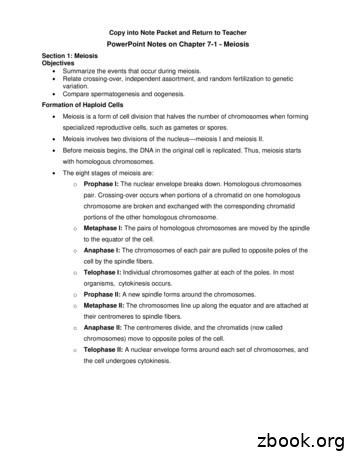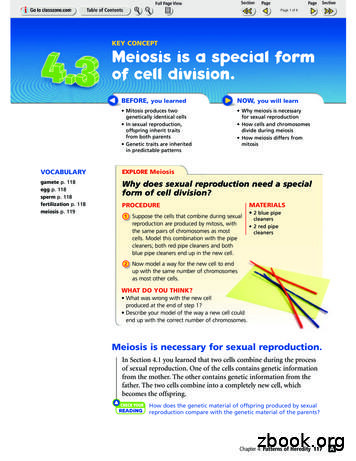12.4 Meiosis
Lesson Overview12.4 Meiosis
Lesson OverviewMeiosisChromosomes—strands of DNA and protein—contain the genes.genes are located in specific positions on chromosomes.Humans receive a set (23) of chromosomes from each parent.23 chromosomes from momthese chromosomes 23 chromosomes from dadare homologous46 total chromosomes or 23 pairsA cell containing both sets of chromosomes is Diploid and is represented bythe symbol 2N. Most body cells are diploid.A cell containing only one set of chromosomes is Haploid and is representedby the symbol N. Gametes (sperm & egg) are haploid.
Lesson OverviewMeiosisMeiosis- process in which the number of chromosomes per cell is cut in half throughthe separation of homologous chromosomes in a diploid cell.- two distinct divisions, called meiosis I and meiosis II.- one diploid cell becomes four haploid cells.
Lesson OverviewMeiosisMeiosis IJust prior to meiosis I, the cell undergoes a round of chromosomereplication called interphase I.Each replicated chromosome consists of two identical or “sister”chromatids joined at the center.
Lesson OverviewMeiosisProphase IHomologous chromosomes pair, forming a structure called a tetrad, whichcontains four chromatids.
Lesson OverviewMeiosisProphase IAs tetrads form, crossing-over occur.chromatids of homologous chromosomes cross over one another.crossed sections of the chromatids are exchanged.Crossing-over produces new combinations of alleles.
Lesson OverviewMeiosisMetaphase IAs prophase I ends, a spindle forms and attaches to each tetrad.During metaphase I of meiosis, paired homologous chromosomes line upacross the center of the cell. Because each homologue could line up on theleft or the right side, this phase provides another opportunity for a newcombination of traits.
Lesson OverviewMeiosisAnaphase I- spindle fibers pull each homologous chromosome pair apart until theseparated chromosomes are clustered at opposite ends of the cell.
Lesson OverviewMeiosisTelophase I and CytokinesisDuring telophase I, a nuclear membrane forms around each cluster ofchromosomes.Cytokinesis follows telophase I, forming two new cells.
Lesson OverviewMeiosisMeiosis Imakes two cells, called daughter cells,each of which has 46 chromosomes (inhumans) .The daughter cells have sets ofchromosomes and alleles that aredifferent from each other and from thediploid cell that started meiosis I.
Lesson OverviewMeiosisMeiosis IIThe two cells produced by meiosis Iundergo a second meiotic division.However neither cell replicates itschromosomes before meiosis II.
Lesson OverviewMeiosisProphase IIchromosomes—each consisting of twosister chromatids—become visible.chromosomes do not pair to formtetrads, because the homologous pairsseparated during meiosis I.
Lesson OverviewMeiosisMetaphase IIchromosomes line up in the center of eachcell.
Lesson OverviewMeiosisAnaphase IISister chromatids separate.
Lesson OverviewMeiosisTelophase IINuclear membranes begin to reform.
Lesson OverviewMeiosisCytokinesisCytoplasm divides to produce 4 haploid daughter cells that are also calledgametes.Male gametes are sperm. Meiosis makes 4 sperm cells in males.In females, meiosis makes 1 egg (oocyte) and 3 polar bodies (ootids).Only the egg is used for reproduction.The polar bodies are either reabsorbed or eliminated from the body.
Lesson OverviewMeiosisGametes to ZygotesFertilization—the fusion of male and female gametes—generates newcombinations of alleles in a zygote.The zygote undergoes cell division by mitosis and eventually forms a neworganism.
Lesson OverviewMeiosisGene LinkageAfter identifying more than 50 fruit fly genes, Thomas Hunt Morgandiscovered that many were “linked” together in ways that seemed to violateMendel’s principle of independent assortment.The linkage groups assorted independently, but all of the genes in one groupwere inherited together
Lesson OverviewMeiosisGene LinkageMorgan’s findings led to two remarkable conclusions:1. each chromosome is actually a group of linked genes.2. chromosomes assort independently, not individual genes.Alleles of different genes tend to be inherited together when those genesare located on the same chromosome.
Lesson Overview. Meiosis. Cytokinesis . Cytoplasm divides to produce 4 haploid daughter cells that are also called gametes. Male gametes are sperm. Meiosis makes 4 sperm cells in males. In females, meiosis makes 1 egg (oocyte) and 3 polar bodies (ootids). Only the egg is used for reproduction.
Cell Division in Sexual Reproduction: Meiosis Meiosis is the mechanism by which eukaryotic cells produce mature sex cells or gametes Meiosis produces four haploid cells (gametes) Meiosis involves partition of both cytoplasmic and nuclear structures Meiosis consists of Meiosis I and Meiosis II. Both phases are followed by .
Meiosis is a form of cell division that halves the number of chromosomes when forming specialized reproductive cells, such as gametes or spores. Meiosis involves two divisions of the nucleus—meiosis I and meiosis II. Before meiosis begins, the DNA in the original cell is replicated. Thus, meiosis starts with homologous chromosomes.
During meiosis, a single cell goes through two cell divisions—meiosis I and meiosis II. Meiosis takes place only in the reproductive tissues of an organism. Cells divide twice during meiosis. Before meiosis begins, the chromosomes of the parent cell are copied. A cell that is ready to divide contains two copies of each
TAKING NOTES Draw a Venn diagram like the one below to summarize the similarities and differences between meiosis I and meiosis II. chromo-somes condense divides homologous chromosomes divides sister chromatids Meiosis I Meiosis II 6.2 Process of Meiosis KEY CONCEPT During meiosis, diploid ce
I II III IV A DNA Replication Mitosis Meiosis Fertilisation B DNA Replication Meiosis 1 Meiosis 2 Fertilisation C Fertilisation Meiosis Mitosis DNA Replication D Mitosis Meiosis 1 Meiosis 2 DNA Replication 4.4 In analysing the number of different bases in a DNA sample, the following result would be consistent with the base-pairing rules: .
Meiosis is a process in which the number of chromosomes per cell is cut in half through the separation of homologous chromosomes in a diploid cell. Meiosis usually involves two distinct divisions, called meiosis I and meiosis II. By the end of meiosis II, the diploid cell becomes four haploid cells.File Size: 796KB
II. Process of Meiosis (6.2) A. Cells go through _ rounds of division in meiosis 1. Meiosis produces _ haploid cells from one diploid cell 2. Process involves two rounds of _ _- Meiosis I and Meiosis II. B. Homologous Chromosomes and sister Chromatids 1.
Now that you've seen how meiosis works, let's review two key differ-ences between the processes of meiosis and mitosis. Meiosis has two cell divisions. Mitosis has only one cell division. Meiosis results in haploid cells. Mitosis results in diploid cells. On the diagram above, circle the part in the process of meiosis























